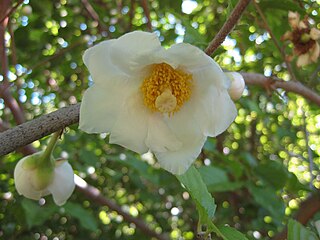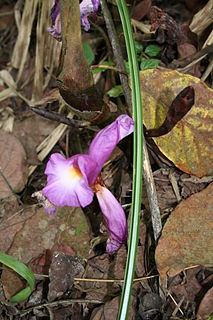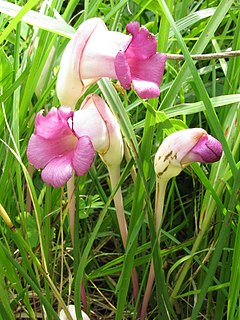
Quassia is a plant genus in the family Simaroubaceae. Its size is disputed; some botanists treat it as consisting of only one species, Quassia amara from tropical South America, while others treat it in a wide circumscription as a pantropical genus containing up to 40 species of trees and shrubs. The genus was named after a former slave from Suriname, Graman Quassi in the eighteenth century. He discovered the medicinal properties of the bark of Quassia amara.

Myrica is a genus of about 35–50 species of small trees and shrubs in the family Myricaceae, order Fagales. The genus has a wide distribution, including Africa, Asia, Europe, North America and South America, and missing only from Australia. Some botanists split the genus into two genera on the basis of the catkin and fruit structure, restricting Myrica to a few species, and treating the others in Morella.

Vismia is a genus of flowering plants in the family Hypericaceae. Members of the genus are small trees and shrubs found in tropical and subtropical areas of Africa, Central America, and South America.

Campylospermum is a genus of plants in the family Ochnaceae.
Magnistipula is a genus of plant in family Chrysobalanaceae described as a genus in 1905.

Maranthes is a genus of plant in the family Chrysobalanaceae described as a genus in 1825.

Monodora is a genus of plant in family Annonaceae. It contains approximately 15 species, distributed throughout tropical Africa.

Olax is a plant genus in the family Olacaceae. The name derives from the Latin, olax (malodorous), and refers to the unpleasant scent of some of the Olax species.

Oncoba is a genus of plants in the family Salicaceae. It contains the following species:
Philippia is a genus of plant in family Ericaceae.

Aframomum is a genus in the ginger family, Zingiberaceae. It is widespread across tropical Africa as well as on some islands of the Indian Ocean. It is represented by approximately 50 species. It is larger than other genera in its family. Its species are perennials and produce colorful flowers.

Cyanastrum is a genus of plants in the family Tecophilaeaceae, native to tropical Africa. It contains three currently recognized species.
Fegimanra is a small genus of trees in the subfamily Anacardioideae of the cashew and sumac family Anacardiaceae. They grow naturally in west and west-central tropical Africa.
Alexander Carroll Maingay was a British physician, botanist and botanical collector.
Meiocarpidium is a genus of plants in the family Annonaceae. It is distributed in Cameroon, The Central African Republic, The Republic of the Congo, and Gabon. Adolf Engler and Ludwig Diels, the German botanists who first formally described the genus, named it after the small number of carpels in the flowers.

Aeginetia is a genus of plants in the broomrape family Orobanchaceae, native mostly to tropical Asia.

Protea madiensis, commonly known as the tall woodland sugarbush, is a flowering shrub which belongs to the genus Protea. It is native to the montane grasslands of Sub-Saharan Africa.











